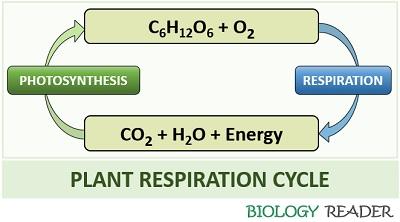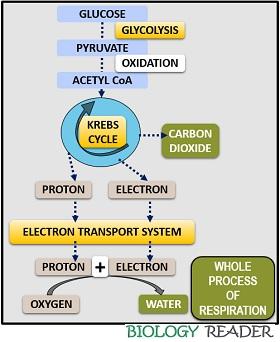Respiration in plants refers to a process in which a plant utilizes atmospheric oxygen to oxidize glucose and other respiratory substrates like fats or proteins. Respiratory substrates are high energy biomolecules that produce energy, carbon dioxide, and water due to the C-C bond breaks.
Plants undergo cellular respiration in the presence or absence of light. Dark respiration may occur in the presence or absence of light. Photorespiration strictly occurs under the action of light.
Plants undergo cellular respiration in three stages. Glycolysis is the first stage of cellular respiration, which takes place inside the cytoplasm and produces energy under anaerobic conditions. Kreb’s cycle is the second stage of aerobic respiration, which occurs inside the mitochondrial matrix.
Oxidative phosphorylation is the last stage of cellular respiration that occurs in the inner mitochondrial membrane via an electron transport system that also occurs in aerobic conditions. In this context, you would get to know the definition, plant respiration cycle, types and mechanism of respiration in plants.
Content: Respiration in Plants
Definition of Respiration in Plants
Respiration in plants refers to a cellular mechanism that involves the complete combustion of glucose and oxygen into by-products like water, carbon dioxide and energy in the form of heat.

In cellular respiration, some of the energy dissipates as heat, while a plant harnesses some energy for the growth processes. Respiration in plants occurs through stomata and lenticels.
Stomata: It’s a plant’s specialized part present in the epidermis layer of the leaves and stems. Bean-shaped guard cells form stomatal pores and promote stomatal opening and closing during the gaseous exchange. Carbon dioxide and oxygen are the gases exchanged during the daytime.
Lenticels: It appears as a pore in the woody trucks or bark of a tree. Lenticels also allow gaseous exchange between the cells and the environment. It is present in the periderm of the stem. Gaseous exchange occurs during the nighttime.
Plant Respiration Cycle
Plants respire 24 hours day and night to carry out the oxidation of glucose into the by-products like carbon dioxide, water and energy. A plant produces glucose and oxygen during photosynthesis by converting carbon dioxide and water under the action of sunlight and chlorophyll. The plant respiration follows the pathway as given in the diagram.

Important Note: Respiration in plants is a process, which spontaneously occurs the whole day. Conversely, photosynthesis only occurs during the daytime, under the sunlight. The respiration rate of plants is higher during the night as photosynthesis ceases.
Cellular Respiration in Plants
Cellular respiration in plants involves three major pathways to oxidize glucose into energy (ATP). In plants, ATP formed during cellular respiration serves as the “Energy currency” that helps in the forming and functioning of different cells.
It involves glycolysis, Krebs cycle and electron transport system for the complete oxidation of a glucose molecule into 38 ATP molecules. The whole process of cellular respiration is depicted in a diagram:

Process
In cellular respiration, glucose first oxidizes into pyruvate by a series of enzymes. Then, pyruvate undergoes oxidation and converts into acetyl coenzyme-A by an enzyme pyruvate dehydrogenase.
The acetyl coenzyme-A enters the Kreb’s cycle and oxidizes to carbon dioxide, protons and electrons through the combination of different enzymes. To know more about glycolysis and the Krebs cycle, one can look at the article difference between glycolysis and Krebs cycle.
Then, the protons and electrons released during the Krebs cycle participate in the electron transport system. The oxygen accepts an electron and combines with a proton to release a water molecule. 38 ATP molecules are produced per glucose molecule after the completion of cellular respiration.
Types of Respiration in Plants
Based on the oxygen requirement, respiration in plants is categorized into two types:

Aerobic Respiration
It occurs in the presence of atmospheric oxygen. A plant uses oxygen for oxidizing high energy organic compound (glucose) into low energy molecules (like water and carbon dioxide). Aerobic respiration in plants releases a high amount of energy, which the plants utilise to drive ATP synthesis.
The ATP further breaks down into ADP and inorganic phosphate and releases energy. Plants utilize the energy to perform cellular functions. Aerobic respiration occurs in the mitochondria with a net production of 38 ATP molecules by the complete oxidation of one glucose molecule.
Anaerobic Respiration
It is intramolecular respiration that occurs in succulent plants like cacti, meristematic tissue, and germinating seeds. It occurs in the absence of oxygen. Anaerobic respiration results in incomplete oxidation of the respiratory substrates into carbon dioxide and ethyl alcohol by releasing little energy.
Thus, anaerobic respiration in plants is related to alcoholic fermentation. The energy released during anaerobic respiration is harnessed to maintain the protoplasmic activity. Anaerobic respiration occurs in the cytoplasm with a net production of 2 ATP molecules. It involves incomplete oxidation of a glucose molecule.
Mechanism of Respiration
Like other living organisms, plants also need oxygen to respire and produce energy. Then, a plant supplies energy to the different parts. In plants, respiration occurs in the roots, stems and leaves. Root hairs, stomata, lenticels are the respiratory parts through which a plant facilitates gaseous exchange.

Respiration in Roots
Root respires by getting the oxygenated air from the soil particles via root hairs. Root hairs are tubular structures and in direct contact with the soil particles. Diffusion of oxygen occurs from the soil particles to the root hairs and finally to the other parts.
During respiration, roots consume oxygen and release carbon dioxide into the atmosphere. A plant again uses the released carbon dioxide to prepare food and release oxygen.
The soil must not be soggy, or soil with excessive water can block free oxygen availability in the soil. There is no oxygen requirement during seed germination in the initial stage, as the testa or seed covering does not allow oxygen to enter.
Respiration is Stems
Stems of herbaceous plants respire through a stomatal pore found in the epidermis of the stem. Stems of woody plants respire via lenticels found in the periderm of the stem, which usually exists as loosely packed dead cells.
Thus, both stomatal pore and lenticels allow the entry of oxygen inside the plant’s intercellular spaces and release carbon dioxide into the atmosphere.
Respiration in Leaves
Small pores present in the lower epidermis layer of the leaf called stomata allow gaseous exchange between the leaves and the environment. Guard cells control the stomatal activity and control the stomatal opening and closing for the gaseous exchange.
It is really interesting to learn more about cells and nature.